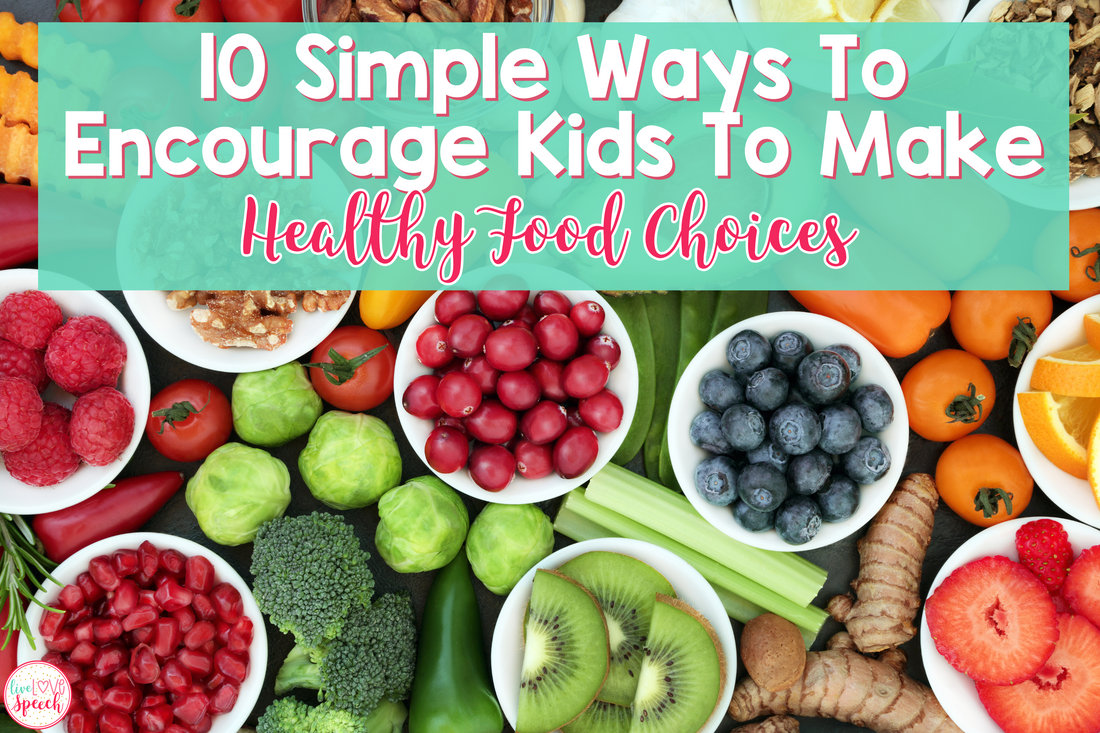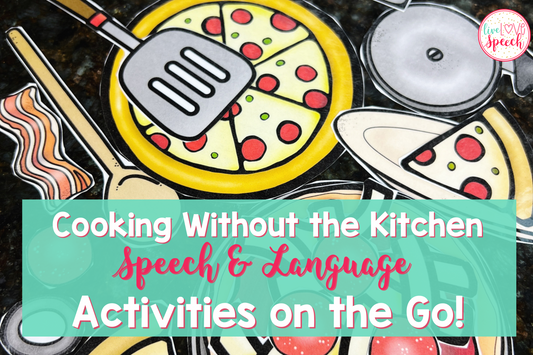
Ever notice how some kids happily munch on veggies while others stick strictly to chicken strips and fries?
I often wondered if it's the kid or possibly the parent/guardian driving these eating habits, and whether there's a way to encourage those french fry enthusiasts to expand their diets.
Because I basically live in the kitchen, I wanted to find out ways to work this out—for you, for me, and all those other teachers and parents wondering the same exact thing. So, that's where I came up with 10 ways to encourage kids to make healthy food choices. Because let's face it, as much as we love chicken nuggets and fries, cooking them daily can get old fast.
For those other parents, teachers and caregivers out there who are itching to expand their cooking skills beyond the realm of kid-friendly basics..... I'm sharing these 10 simple ways to encourage kids to make healthy food choices.
10 Simple Ways to Encourage Kids to Make Healthy Food Choices

1. Lead By Example:
Teaching kids to make healthy food choices from an early age empowers them to take control of their health and fosters a positive relationship with food that can last a lifetime. Children often mimic the behavior of adults, so it's important to model healthy eating habits yourself. Let them see you enjoying a variety of nutritious foods and making healthy choices in your own diet.
By showing them firsthand the importance of balanced nutrition and the joy of exploring new foods, you provide them with invaluable guidance on their journey toward a healthier lifestyle. After all, how else would they know what to eat if they don't see it in action?
2. Offering a Variety of Healthy Food Choices:
Provide a wide selection of healthy snacks and meals for children to choose from. Include a variety of fruits, vegetables, whole grains, lean proteins, and dairy products to expose them to different flavors and textures. Children are naturally curious, and by offering a diverse range of nutritious foods, we not only ensure they receive a balanced diet but also encourage them to explore new tastes and develop a more adventurous palate.
Try incorporating colorful fruits and vegetables into fun snacks or meals, like carrot sticks with hummus or a fruit salad with yogurt dip. By making healthy options readily available and appealing, this will help them make nutritious choices even when we are not around.

3. Educate About Nutrition:
Teach children about the importance of nutrition and how different foods fuel their bodies. Use age-appropriate resources like books, videos, or games to make learning about nutrition fun and engaging. For example, the book 'Eating the Alphabet' by Lois Ehlert is a fantastic tool for teaching kids about fruits and vegetables while exploring the alphabet. Each page features a different fruit or vegetable, from apples to zucchini, accompanied by vibrant illustrations and simple text. Parents can use this book as a springboard for discussions about the benefits of eating a variety of colorful fruits and vegetables and how they provide essential vitamins and minerals to keep our bodies healthy and strong.
Additionally, consider integrating food-themed books into your child's reading routine. I've assembled a list of 10 food-themed books for kids on my blog, each one combining fun storytelling with valuable lessons about healthy eating. These books not only spark children's imaginations but also inspire them to get involved in cooking and exploring new foods. Read more about these books here. By making nutrition education enjoyable and accessible, we can help children make informed food choices.
4. Involve Children in Meal Planning and Preparation:

Allow children to participate in meal planning and preparation activities. Let them help choose recipes, shop for ingredients, and assist in cooking or assembling meals. This not only teaches them valuable cooking skills but also gives them a sense of ownership over their food choices.
Visual recipes are also a great way to do this. My visual recipe cards offer the option of Real Meals. These are not only for kids but ADULTS too! Such as my Yummy Mac and Cheese, Berry Yogurt Parfait, and Avocado toast, there are recipes for breakfast, lunch and dinner! Trust me; you will love them just as much. They are visual recipes that include step-by-step visual instructions that give your kids the confidence to follow along in meal preparation. You can find these cards here!
By involving kids in meal planning and preparation, we are instilling in them a sense of responsibility and independence but a positive relationship with food. Plus, it's a great opportunity to get some quality family time in.

5. Make Healthy Foods Options Accessible and Visible:
Keep healthy snacks readily available and easily accessible in your classroom or home. Display fruits and vegetables in a colorful and enticing way to encourage children to reach for them. Consider placing a bowl of fresh fruit on the kitchen counter or a plate of sliced vegetables on the dining table for easy access. In the classroom, set up a designated snack area with baskets of apples, bananas, and baby carrots where children can help themselves between lessons.
You can even create a 'snack station' in the fridge with pre-cut fruits and veggies stored in clear containers for quick and healthy snacking. By making healthy foods visible and convenient, we make it easier for children to make nutritious choices throughout the day.
Additionally, consider leaving out unhealthy snacks or sugary treats to reduce temptation and promote healthier eating habits. With a little creativity and planning, we can create environments that support and encourage healthy eating for children both at home and in educational settings.
6. Encourage Exploration and Experimentation:
Encourage children to try new foods and flavors by offering tasting sessions or food sampling opportunities. Create a positive and adventurous atmosphere where children feel comfortable exploring different foods without pressure. At home, you can set up a 'tasting table' using a cupcake muffin tin, filling each compartment with small portions of various fruits, vegetables, cheeses, and dips for children to sample. Make it a fun and interactive experience by letting them use toothpicks or small tasting spoons to try each item. You could also involve them in meal planning by asking them to pick out a new vegetable or grain to try in a recipe.
In the classroom, incorporate tasting sessions into lessons about nutrition or cultural diversity. For example, you could organize a 'fruit of the week' activity where children learn about and taste a different fruit each week. Alternatively, host a 'global snacks day' where children bring in snacks from different countries to share with their classmates.
By providing opportunities for exploration and experimentation, we not only expand children's palates but also foster a sense of curiosity and openness to new experiences that will serve them well throughout their lives.
7. Promote Mindful Eating:
Teach children to listen to their bodies and pay attention to hunger and fullness cues. Encourage them to eat slowly, savor their food, and be mindful of portion sizes. By fostering mindfulness around eating, children develop a deeper connection with their bodies and food, which can lead to healthier eating habits and a more positive relationship with food.
Discuss with your kiddos what isn't mindful eating and the various consequences. For example, talk about if they eat too quickly and not realize when they're full, which can result in overeating and feeling uncomfortable afterwards. Eating mindlessly while watching TV or playing games could cause them to not pay attention to the taste or texture of their food, missing out on the enjoyment of the eating experience. They might also grab snacks out of boredom rather than hunger, leading to unnecessary calorie intake. By discussing these potential outcomes with your kids, you can help them understand the importance of being mindful during meals and snacks, and how it can contribute to their overall health and well-being.
8. Celebrate Healthy Food Choices:
Recognize and celebrate children's healthy food choices with praise and positive reinforcement. Create a fun system to motivate them to make healthier choices on a regular basis. For example, you could create a 'healthy eating chart' where children can track their daily fruit and vegetable intake or try a new healthy food. This is something fun you can do without adding any pressure! Each time they meet a goal, they could be rewarded with something they enjoy or even a special outing. Avoid using actual food as a reward or punishment and instead focus on enjoying the experience of eating together.
Another idea is to make healthy eating a family affair by planning a fun cooking night where everyone works together to prepare a nutritious meal. You could also organize a 'healthy snack taste test' where children get to sample different healthy snacks and vote for their favorites. By making healthy choices enjoyable and rewarding, children are more likely to embrace them.

9. Engage in Food-Related Activities:
Incorporate food-related activities into your curriculum or daily routine, such as gardening, cooking demonstrations, or nutrition-themed crafts. These hands-on experiences help reinforce the importance of healthy eating in a fun and interactive way. For instance, you could set up a classroom or home garden where children can grow their own fruits, vegetables, and herbs. This not only teaches them about where food comes from but also encourages them to try new foods they've grown themselves.
Additionally, consider using my cooking and craft pack, which includes healthy options such as a strawberry banana shake, English muffin pizza, fruit pizzas, and more! These recipes are not only delicious but also simple and nutritious, making them perfect for cooking demonstrations with children. You can involve them in every step of the process, from selecting the ingredients to preparing and cooking the meals. Click here for your Cooking & Craft Pack.
Another idea is to host nutrition-themed crafts, where children can create fun and educational projects related to healthy eating. For example, they could make fruit-themed collages or create their own food pyramid using colored paper and glue.
10. Foster a Positive Food Environment:

Foster a Positive Food Environment: Create a positive and supportive food environment where children feel empowered to make healthy choices without judgment or criticism. Encourage them to listen to their bodies and trust their instincts when it comes to food. One way to create such an environment is by involving children in meal planning and preparation, as we discussed earlier. By letting them contribute ideas, choose recipes, and participate in cooking, they develop a sense of ownership over their meals and feel more invested in making healthy choices.
Lead by example by modeling healthy eating behaviors yourself and avoiding negative comments about food or body image. Celebrate all food choices, whether they're healthy options or occasional treats, and emphasize the importance of balance and moderation. Another strategy is to create a relaxed and enjoyable mealtime atmosphere, free from distractions like screens or stressful conversations. Encourage positive conversation and connection during meals, and make it a priority to eat together as a family whenever possible.
I hope you find these tips helpful in your day-to-day life with your kids or students. Getting them on track with healthier options can make mealtime a breeze for you and bring some fun to the table too! Plus, it's a win-win situation—they'll benefit from healthier choices and you'll enjoy a smoother meal prep routine. Let's cheers to happier, healthier eating
SAVE THIS POST FOR LATER
Don't forget to save this post on Pinterest so you'll be all set when you're ready to start encouraging your kids to make healthy food choices!!





